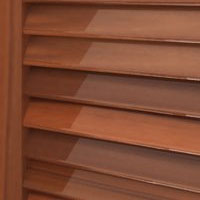Glossary of Shutter Terms

Definitions to guide you when purchasing wooden shutters.
- Batten - Horizontal member of a board and batten shutter
- Bead - A millwork detail that is often used on the opposite face of a shiplap. Is also used in trim, and interior details of shutters
- Chevron - A type of louver that is rectilinear, rather than bull nosed
- Color Matched - A specification level above stain grade that attempts to minimize the color variation in a given species and grade of wood that may vary due to age of tree, growing conditions, mineral content etc. A matter of preference as aficionados often prefer to see the full range of color and grain in a species
- Cut Out - Decorative detail that cuts a pattern out of a paneled or board shutter, such as a star, tree or candle
- Faux Lift Rod - An approximation of an operable lift rod that visually looks as though it might work, but in fact, has no effect on the louvers as it is not connected and the louvers are fixed
- Fixed Louver - Louvers that are fastened in a frame in one position only, and can not have their pitch altered
- Jointing - An important operation in high end millwork, furniture and cabinetry. It is the process of flattening a board by hand to progressively obtain a smooth, straight surface on one face of the board, while relieving stress. It is a time consuming operation requiring skill, that is often overlooked by other manufacturers in favor of planing
- Lift Rod - A dowel that runs the full face length of a field of louvers and allows the louvers to be opened or closed
- Louver Pitch - The angle of the louver as viewed in section through the stile
- Louver Spacing - The distance from the center of one louver to the center of the louver above it
- Moisture Content - An important measure of the quality of wood used in millwork. Generally speaking, the higher the moisture content, the more susceptible wood is to environmental factors such as humidity and temperature. Estate Millwork has stringent standards and produces millwork at the optimal moisture content of 6-8%, which minimizes the chances of deformation in the field
- Mortise - A thick, machined slot in the stile that receives the male tenon from the rail, forming the strongest possible millwork joint
- Mouse Hole - A milled recess in a rail that allows a lift rod to set below the front face of the shutter in the closed position
- Paint Grade - A grade of lumber that may have visual defects, such defects which will not be apparent under a coat of paint
- Peg - A small dowel that can be inserted into a hole drilled through the mortise and tenon that gives additional stability to the joinery. Sometimes, for charm and accent, the dowel is from a different species of wood
- Planing - the process of progressively smoothing one face of a board, under pressure as the board is cut from the top, while pressure holds it onto a flat bed underneath the board. Will not remove cup or bow, and is inferior to jointing for getting stock square and flat
- Rail - Horizontal frame member of a shutter
- Rail Placement - The vertical location of a rail in a rail and stile frame
- Raised Panel - A rectangular panel that has a profile cut into it that starts at the edge (tongue) of the panel and proceeds inwards into the panel. The reveal of the panel is the width of the cut of the raise, typically ranging from 1 - 3 inches
- S4S - A "Square on 4 Sides" profile of lumber, which is the simplest sticking profile
- Shiplap - A rabbeted edge on opposing sides of a pair of shutters. Allows for an overlapped fit
- Spanish Cedar - A premium grade hardwood that has better strength, density, hardness and stability than the lower grade softwoods such as Western Red Cedar, American White Cedar, Incense Cedar and Aromatic Cedar
- Splined Glue Joint - A method of machining the meeting edges of two narrow boards that will be glued to form a wider board or panel. Other inferior methods include a butt joint, or a T&G joint that are often used by our competitors to save time, at the expense of quality. A splined glue joint has more than double the surface area of a but joint
- Stain Grade - A higher grade of lumber that minimizes the number of knots, worm holes and variation. May or may not be desirable dependent upon tastes
- Sticking - Moulded lines, beads and waves in the rails and stiles of a door. Includes a positive profile which is run on the inside edges of all rails and stiles, and a negative "cope" which allows the edges of the rails to mate perfectly with the profiled stile
- Stile - Vertical frame member of a shutter
- Tenon - A protruding tongue that fits into the female mortise in the stile. Often tenons are wedged, pegged or glued for additional strength
- Z-Brace - Diagonal brace that connects two battens to add strength to shutters and doors, especially larger ones that will be hinged

